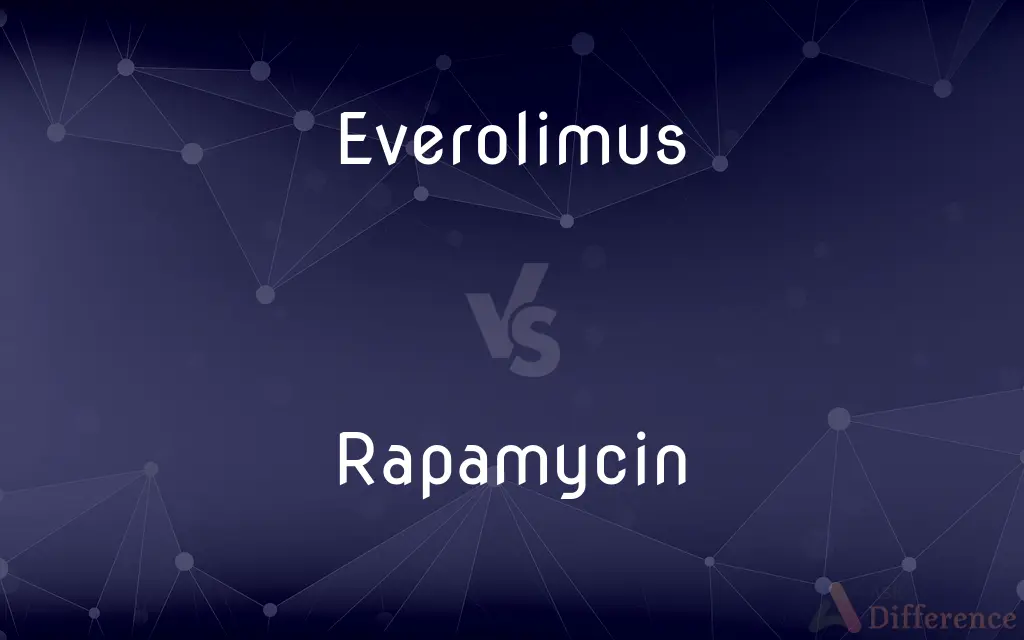Everolimus vs. Rapamycin — What's the Difference?
By Urooj Arif & Fiza Rafique — Updated on April 9, 2024
Everolimus is a derivative of rapamycin, tailored for enhanced pharmacokinetic properties, whereas rapamycin is a natural antibiotic and immunosuppressant.

Difference Between Everolimus and Rapamycin
Table of Contents
ADVERTISEMENT
Key Differences
Everolimus, also known as RAD001, is a derivative of rapamycin designed to overcome some of the limitations of rapamycin, including its pharmacokinetic profile. It is used in medicine to prevent organ rejection after transplantation and to treat various types of cancer and tuberous sclerosis complex. On the other hand, rapamycin, originally discovered as an antifungal agent, has broad applications, including as an immunosuppressant to prevent organ transplant rejection and in the research of aging and disease due to its mTOR inhibiting properties.
While both everolimus and rapamycin act by inhibiting the mammalian target of rapamycin (mTOR), a critical regulator of cell growth and proliferation, everolimus has been modified to have better oral bioavailability and a more predictable pharmacokinetic profile. This makes everolimus particularly useful in settings where precise dosing and drug levels are critical, such as in the treatment of cancer.
The side effects of everolimus can include mouth ulcers, infections, and lung or breathing problems, which are somewhat similar to those of rapamycin but may vary in frequency and severity due to the different formulations and dosages used. Rapamycin’s side effects also include an increased risk of infections and can affect lipid and glucose metabolism.
Everolimus is approved for specific medical conditions by regulatory bodies such as the FDA and EMA, reflecting its targeted therapeutic uses. In contrast, rapamycin, although used in clinical settings, has garnered significant interest in research for its potential lifespan-extending properties and its role in managing autoimmune diseases, cancer, and neurodegenerative disorders.
The cost and availability of everolimus versus rapamycin vary, with everolimus often being more expensive due to its specific medical applications and patent protections. Rapamycin, being older and used in a wider range of research and clinical contexts, may be more readily available in generic forms.
ADVERTISEMENT
Comparison Chart
Derivation
Derivative of rapamycin
Natural compound
Primary Use
Cancer treatment, organ transplant
Organ transplant, research on aging
Mechanism
Inhibits mTOR
Inhibits mTOR
Pharmacokinetics
Enhanced bioavailability
Variable bioavailability
Side Effects
Mouth ulcers, infections
Increased infection risk, impacts on metabolism
Regulatory Approval
Specific conditions (cancer, TSC)
Broader, including organ transplant
Cost
Generally higher
Lower, available in generic form
Compare with Definitions
Everolimus
Enhances pharmacokinetic properties for targeted therapy.
The design of everolimus allows for more predictable drug levels in cancer treatment.
Rapamycin
A natural antibiotic and immunosuppressant with a broad range of uses.
Rapamycin is used to prevent organ rejection in liver transplant patients.
Everolimus
Approved for specific medical conditions like tuberous sclerosis complex.
Everolimus has shown promise in shrinking brain tumors associated with TSC.
Rapamycin
Research focuses on its potential to extend lifespan and treat diseases.
Studies on mice have shown that rapamycin can increase lifespan.
Everolimus
A medication used to prevent organ rejection and treat certain cancers.
Everolimus is prescribed to kidney transplant patients to prevent rejection.
Rapamycin
Originally discovered for its antifungal properties.
Despite its antifungal discovery, rapamycin’s immunosuppressive qualities garnered more interest.
Everolimus
Can cause side effects like mouth ulcers and infections.
Patients taking everolimus may require monitoring for possible lung complications.
Rapamycin
Acts by inhibiting the mTOR pathway, affecting cell growth.
The inhibition of mTOR by rapamycin has applications in cancer treatment and research.
Everolimus
A derivative of rapamycin with a modified molecular structure.
Everolimus's structure increases its oral bioavailability compared to rapamycin.
Rapamycin
May affect lipid and glucose metabolism, leading to side effects.
Patients on rapamycin therapy are monitored for changes in blood sugar and cholesterol levels.
Everolimus
Everolimus, sold under the brand name Afinitor among others, is a medication used as an immunosuppressant to prevent rejection of organ transplants and as a targeted therapy in the treatment of renal cell cancer and other tumours.It is the 40-O-(2-hydroxyethyl) derivative of sirolimus and works similarly to sirolimus as an inhibitor of mammalian target of rapamycin (mTOR).It is marketed by Novartis under the trade names Zortress (US) and Certican (European Union and other countries) in transplantation medicine, and as Afinitor (general tumours) and Votubia (tumours as a result of Tuberous Sclerosis Complex (TSC)) in oncology.It is on the World Health Organization's List of Essential Medicines. It is available as a generic medication.
Rapamycin
See sirolimus.
Everolimus
(pharmaceutical drug) A derivative of rapamycin, used as an immunosuppressant to prevent rejection of organ transplants.
Rapamycin
(pharmaceutical drug) sirolimus.
Common Curiosities
What are the side effects of everolimus?
Side effects can include mouth ulcers, infections, and lung or breathing problems.
How does rapamycin work?
Rapamycin works by inhibiting the mTOR pathway, which is crucial for cell growth and proliferation.
What is everolimus used for?
Everolimus is used to prevent organ rejection and to treat various cancers and tuberous sclerosis complex.
Is rapamycin still used in clinical settings?
Yes, rapamycin is used as an immunosuppressant in organ transplant patients and in research contexts.
How do the costs of everolimus and rapamycin compare?
Everolimus generally costs more due to its specialized applications and patent protections, while rapamycin may be cheaper, especially in generic form.
Why is everolimus preferred over rapamycin for some conditions?
Everolimus has better oral bioavailability and a more predictable pharmacokinetic profile, making it suitable for precise dosing in specific conditions like cancer.
How are everolimus and rapamycin related?
Everolimus is a derivative of rapamycin, designed to improve upon some of rapamycin's properties.
What regulatory approvals does everolimus have?
It is approved for conditions such as certain cancers and tuberous sclerosis complex by bodies like the FDA and EMA.
Can rapamycin extend lifespan?
Research in animals has suggested that rapamycin can extend lifespan, though its effects in humans are still under investigation.
What research is being done on rapamycin?
Research on rapamycin spans its role in aging, autoimmune diseases, cancer, and neurodegenerative disorders.
Are everolimus and rapamycin the same?
No, everolimus is a derivative of rapamycin with modifications for specific medical uses.
What makes rapamycin unique among immunosuppressants?
Its broad research applications, including potential lifespan extension and disease treatment, set it apart from other immunosuppressants.
How are everolimus and rapamycin administered?
Both can be administered orally, but the dosing and formulation may vary based on the condition being treated.
Can everolimus be used for all the same conditions as rapamycin?
Everolimus is approved for specific conditions and may not be suitable for all of rapamycin’s uses due to different pharmacokinetic properties.
What is the mechanism of action for both drugs?
Both drugs inhibit the mTOR pathway, affecting cell growth and proliferation.
Share Your Discovery

Previous Comparison
Garbage vs. Recycling
Next Comparison
Goading vs. TauntingAuthor Spotlight
Written by
Urooj ArifUrooj is a skilled content writer at Ask Difference, known for her exceptional ability to simplify complex topics into engaging and informative content. With a passion for research and a flair for clear, concise writing, she consistently delivers articles that resonate with our diverse audience.
Co-written by
Fiza RafiqueFiza Rafique is a skilled content writer at AskDifference.com, where she meticulously refines and enhances written pieces. Drawing from her vast editorial expertise, Fiza ensures clarity, accuracy, and precision in every article. Passionate about language, she continually seeks to elevate the quality of content for readers worldwide.














































